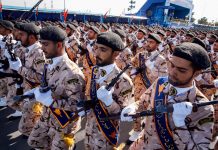Hezbollah’s Urban Missile Factories Put Civilians at Risk
Hanin Ghaddar and Matthew Levitt/The Washington Institute/October 04/2020
مصانع صواريخ حزب الله في المناطق السكنية تعرّض المدنيين للخطر
حنين غدار وماثيو ليفيت/معهد واشنطن/03 تشرين الأول/2020
في حديثه أمام الجمعية العامة للأمم المتحدة في 27 أيلول/سبتمبر، اتهم رئيس الوزراء الإسرائيلي بنيامين نتنياهو، «حزب الله» ببناء مواقع لإنتاج الصواريخ في حي الأوزاعي في بيروت. وتفيد بعض التقارير أن الحزب يعتزم تحويل الصواريخ العادية في هذه المنشآت السرية الواقعة في قلب منطقة حضرية، بالقرب من المساجد والمنازل والمدارس والمطار الدولي، إلى أسلحة دقيقة وأكثر اتقاناً. ومن غير الواضح ما إذا كانت هذه المواقع قد بدأت تعمل بالفعل أم لا.
لقد أوضحت إسرائيل مراراً وتكراراً أنها لا تستطيع السماح لـ «حزب الله» بإنتاج أنواع جديدة من الصواريخ أو تطوير مخزونها الحالي محلياً. ومع ذلك، يواصل االحزب سعيه لتحقيق هذا الهدف بالذات، معرّضاً حياة اللبنانيين وممتلكاتهم لخطر هائل خلال العملية.
مشروع الدقة الصاروخية
في غضون دقائق من خطاب نتنياهو، نشر الجيش الإسرائيلي مقاطع فيديو وصوراً لثلاثة مواقع في بيروت، التي وفقاً لبعض التقارير أُنشئت لتحسين دقة صواريخ «حزب الله» – وهو هدف ربطه رئيس الوزراء الإسرائيلي مباشرة بإيران. كما أن كشفه لهذه التطورات أمام الأمم المتحدة، هو ليس بأي حال من الأحوال المرة الأولى التي تشير فيها إسرائيل إلى أنها تتابع مثل هذه الجهود عن كثب.
وعندما اجتمع نتنياهو مع الرئيس الروسي فلاديمير بوتين في موسكو في كانون الثاني/يناير الماضي، ناقش الإثنان منشآت الصواريخ التي كان يبنيها «حزب الله» في لبنان. وفي ذلك الوقت، حذّر نتنياهو من أن تلك البلاد “أصبحت مصنعاً للصواريخ الموجهة بدقة التي تهدد إسرائيل”.
ثم في أيار/مايو، أثناء استضافة قائد “سلاح الجو الإسرائيلي” الجنرال عميكام نوركين لاجتماع لنظرائه الأجانب، عرض صورة لمقاتلة الشبح من طراز “أف-35” وهي تحلق فوق بيروت في وضح النهار. وكانت التداعيات المترتبة على ذلك الاستعراض للقوة، ذات شقين: أولاً، بإمكان إسرائيل ضرب أهداف في بيروت متى شاءت، ثانياً، هناك أهدافاً في العاصمة شعرت إسرائيل بأنها قد تضطر إلى ضربها. وقد جعل نتنياهو هذا التهديد صريحاً وواضحاً عندما أظهر في الأمم المتحدة صوراً جوية لمواقع الصواريخ في بيروت، محذراً: “إسرائيل تعلم ما تفعلون، وإسرائيل تعرف أين تقومون بذلك. وإسرائيل لن تسمح لكم بالإفلات من دون عقاب.”
وفي حديث لنائب رئيس الموساد السابق نفتالي غرانوت في مؤتمر لمحاربة الإرهاب في أوائل أيلول/سبتمبر، أشار إلى أن «حزب الله» “تلقى مؤخراً عدداً قليلاً من الأنظمة الدقيقة التوجيه التي تعتمد على نظام تحديد المواقع والتي ستساعده على تحويل بعض الصواريخ الثقيلة إلى صواريخ دقيقة”. وفي وقت لاحق من ذلك الشهر، أفادت بعض التقارير عن استهداف غارات جوية إسرائيلية في سوريا للأجهزة المتخصصة لإنتاج الصواريخ الدقيقة التوجيه، والتي كانت في ذلك الوقت في طريقها إلى «حزب الله». ودفعت تلك الهجمات وحدات الدفاع الجوي السورية إلى إطلاق موجة من القذائف بشكل عشوائي، متسببة في إسقاط طائرة عسكرية روسية بطريق الخطأ، مما عقّد الصعوبات التي تعترض العمليات الجوية الإسرائيلية ضد الأسلحة الاستراتيجية التابعة للحزب.
استخدام الدروع البشرية
لا يمثل الكشف الخاص ببيروت المرة الأولى التي يُضبَط فيها «حزب الله» مستخدماً المدنيين اللبنانيين كدروع بشرية للأسلحة أو منشآت الإنتاج. ففي تموز/يوليو 2017، على سبيل المثال، نشرت إسرائيل صوراً جوية لأماكن في القرى الجنوبية تُظهر أن أن الحزب قام ببناء مصنع للصواريخ ومخزن للأسلحة. وكانت إحدى البنايات تقع على بعد حوالي 110 أمتار من مسجدين. وقد أفاد “جيش الدفاع الإسرائيلي” في ذلك الوقت أن «حزب الله» يقيم بشكل اعتيادي مواقع إطلاق الصواريخ ومواقع إطلاق نار أخرى في وسط مناطق مأهولة بالسكان، إلى جانب تشييده “شبكة من الأنفاق تحت الأرض في أسفل المنازل والمباني المدنية للسماح لمقاتليه بالتحرك بحرية بين المواقع.”
وبالمثل، كثيراً ما أقام الحزب البنى التحتية العسكرية بالقرب من المدنيين خلال حرب لبنان عام 2006. على سبيل المثال، في قرية قانا الشيعية الجنوبية، أظهرت صور من النزاع مستودعاً للأسلحة يقع مباشرة في شارع مقابل مسجد. وفي هذا الإطار، كانت نحو ثلاثين مجموعة من مقاتلي «حزب الله» تنفذ عملياتها من قرية عيتا الشعب، حيث تمركز العديد من عناصرها داخل منازل.
ويدرك الحزب مدى خطورة هذا التكتيك على مواطني البلاد. وفي الواقع، استخدم عن قصد مواقع مدنية حساسة كمرافق عسكرية خلال حرب 2006 بعلمه أنها ستتعرض للهجوم، إذ كان يعتقد على ما يبدو أن ذلك سيزيد من صعوبة العمليات الإسرائيلية في جنوب لبنان. وعندما سُئل بعد ذلك جندي معتقل من «حزب الله»، محمد عبد الحميد سرور، ما إذا كان يعلم أن إطلاق صاروخ على دبابة إسرائيلية من منزل مدني سيؤدي حتماً إلى تدمير ذلك المنزل، أجاب بأن إطلاق النار لا يزال يصب “في المصلحة الإسلامية العامة”، و”إذا تم تدمير المنزل، فسيتم، بكل بساطة، إعادة بنائه بعد الحرب”. كما أن ادعاءه بأنه كان من المفترض أن يتم إخلاء جميع المنازل قبل بدء القتال يبدو بمثابة عزاء مريب بالنسبة للمتضررين، حتى لو كان ذلك صحيحاً.
وتساعد هذه الطريقة من التفكير في تفسير سبب تكثيف جهود الحزب على ما يظهر على إنشاء بنية تحتية خاصة بإنتاج الأسلحة داخل لبنان في السنوات التي أعقبت تلك الحرب المدمرة. ففي تموز/يوليو 2017، نشرت المجلة الفرنسية “إنتلجنس أونلاين” معلومات تؤكد أن «حزب الله» يقوم ببناء مصنعين محليين جديدين للأسلحة: أحدهما بالقرب من البلدة الشمالية الهرمل ويهدف إلى إنتاج صواريخ “فاتح – 110” الأبعد مدى، وآخر بين مدينتي صيدا وصور الجنوبيتين الساحليتين ويرمي إلى إنتاج ذخائر أقل [عياراً]. وفي وقت سابق من ذلك العام، ذكرت صحيفة “الجريدة” الكويتية نقلاً عن نائب لرئيس «الحرس الثوري الإسلامي» الإيراني، لم تكشف عن اسمه، أن إيران أنشأت مرافق متعددة على عمق خمسين متراً تحت سطح الأرض وقامت بحمايتها من القصف الإسرائيلي من خلال [وضع] طبقات متعددة من الدفاعات.
ليس في عقر داري
بعد حرب عام 2006، قبِل أنصار «حزب الله» بسرد “النصر الإلهي” الذي روّج له الحزب، باعتقادهم أن النتيجة ستردع الهجمات الإسرائيلية المستقبلية وتحصد تعويضات مالية من إيران. ومع ذلك، كان هذا يعني أيضاً أنهم اعتبروا الحرب بمثابة الجولة الأخيرة في الأعمال العدائية الرئيسية ضد إسرائيل.
وفي الواقع، شجعت فترة الهدوء الطويلة نسبياً (2006 – 2018) على طول الحدود إلى بدء العديد من الشيعة بالتفكير في المستقبل، على النقيض من طريقة تفكيرهم السابقة التي ركزت على قيام حروب دائمة. وفي الآونة الأخيرة، انتشرت أعمال تجارية جديدة في معاقل شيعية مثل ضاحية بيروت الجنوبية و[المناطق] الجنوبية منها. وتم افتتاح الفنادق والمطاعم والمقاهي الحديثة في كل بلدة رئيسية، بدعم من المستثمرين الشيعة داخل البلاد وخارجها. وقد استمرت هذه العقلية من تنظيم المشاريع على الرغم من الحرب الدائرة في سوريا المجاورة. وفي الوقت نفسه، سيستفيد الاقتصاد الوطني بشكل كبير من الاستكشاف المزدهر لمصادر الطاقة في البحر المتوسط.
ويدرك «حزب الله» أن العلامات المتزايدة التي تنذر بوقوع نزاع آخر مع إسرائيل قد تعرقل مثل هذه التطورات. وعلاوة على ذلك، إذا اندلعت الحرب، فمن المحتمل أن يعلم اللبنانيون أن التمويل لإعادة البناء الذي سيتلقونه من دول الخليج العربية سيكون أقل بكثير مما حصلوا عليه بعد الحرب السابقة، ويعزى ذلك إلى التوتر السني -الشيعي المتصاعد وإلى تعب الجهات المانحة. ويبدو ذلك وكأنه إدراك واقعي نظراً إلى التحسين الواسع النطاق لترسانة «حزب الله» وقواته، مما سيزيد من الدمار المتوقع للحرب القادمة ويدفع عملية إعادة الإعمار إلى ما يتخطى السبع سنوات التي اعترف بها الحزب بأنها كانت ضرورية للتعافي من الحرب الأخيرة. باختصار، يشعر الشيعة أن لديهم الكثير ليخسروه اليوم، لذا فهم أقل تسامحاً تجاه المسؤولين الذين يتحدثون عن دخول حرب مع إسرائيل.
توصيات سياسية
في ضوء هذا التغيير في المواقف، قد يكون فضح مصانع الصواريخ التابعة لـ «حزب الله» الطريقة الأكثر فعالية لاستغلال الخلافات داخل قاعدة الحزب، وربما لجعله يفكر مرتين حول فكرة صنع الأسلحة داخل لبنان. فعندما كشف نتنياهو عن الأماكن الدقيقة للمواقع في بيروت، كان لدى الأشخاص الذين يعيشون بالقرب منها – ومعظمهم من المدنيين الشيعة الذين يدعمون «حزب الله» – أسباباً كافية تدعوهم للقلق من أن تقوم إسرائيل بقصف المنشآت في مرحلة ما، مما قد يدمر منازلهم ويقتل أحباءهم في المنطقة أثناء العملية.
ولا تبدو بدائل هذا التعرض مشجعة. فمن غير المرجح أن تفعل الحكومة اللبنانية شيئاً حول إنتاج «حزب الله» للأسلحة المحلية. بل على العكس من ذلك، أثبتت بيروت مراراً وتكراراً استعدادها لتغطيته، كما أن انتخابات أيار/مايو زادت من تأثير “حزب الله” ونفوذ إيران على القرارات الأمنية والعسكرية للبلاد. ومن غير المحتمل أيضاً أن تتصرف “قوة الأمم المتحدة المؤقتة في لبنان” (“يونيفيل”) بهذا الشأن نظراً لكونها بعثة مراقبة.
ومع ذلك، قد يتخذ الأشخاص الذين يعيشون فوق منشآت القذائف التابعة لـ «حزب الله» وحولها، بعض الإجراءات. فبعد حرب عام 2006، طالب بعض السكان في الجنوب بأن يزيل الحزب صواريخه من أراضيهم. ومن المرجح أن يقدّم الكثير من الجنوبيين – إلى جانب الشيعة الذين يعيشون في ضواحي بيروت ووادي البقاع – مطالبات مماثلة إذا ما اعتقدوا أن «حزب الله» يخاطر بحياتهم وسط حرب تلوح في الأفق. وحتى إذا رفض الحزب هذه المطالب في نهاية المطاف، فسوف يُجبَر على الأقل على إدارة علاقة أكثر تعقيداً مع مناصريه الأساسيين. لذلك، يجب الكشف عن المزيد من هذه المواقع، لا سيما تلك الموجودة في المناطق المكتظة بالسكان.
بالإضافة إلى ذلك، إن دعم إيران لعملية تطوير الصواريخ التي يقوم بها «حزب الله» يشكّل انتهاكاً مباشراً لقرار مجلس الأمن الدولي رقم 1701 الذي أنهى حرب عام 2006، ونصّ على “عدم بيع أو توريد الأسلحة والعتاد ذات الصلة إلى لبنان باستثناء ما تأذن به حكومته”. وسيجد «حزب الله» صعوبة في استغلال ذلك الاستثناء نظراً لأنّ واشنطن وأوروبا والدول العربية الرئيسية تعتبره منظمة إرهابية، كلياً أو جزئياً.
لذا ينبغي على مجلس الأمن والمجتمع الدولي الأوسع النظر في تعزيز القرار 1701 وتطبيقه، سواء من خلال الحكومة اللبنانية أو تمشياً مع الفصل السابع من ميثاق الأمم المتحدة. وتتمثّل الخطوة الجيدة الأولى في تكليف رقابة دولية على مطار بيروت، والتي يمكن أن تشمل مراقبة الرحلات الجوية وتفتيش البضائع لضمان عدم وصول أي أسلحة أو أجزاء ذات صلة إلى «حزب الله».
وفي نهاية المطاف، إذا كانت المعلومات الاستخباراتية عن المواقع في بيروت دقيقة، فقد تشعر إسرائيل فعلاً أنها مضطرة لمهاجمتها، مثلما فعلت في سوريا. وحتى إذا كان فضح مثل هذه المواقع لا يقنع «حزب الله» بتفكيكها، فقد تتصدى إسرائيل على الأقل لرواية الحزب بأن “المقاومة” هي أفضل وسيلة للدفاع عن لبنان ولمساعدة الطائفة الشيعية على الازدهار.
*حنين غدار هي صحفية وباحثة لبنانية محنكة، وزميلة زائرة في زمالة “فريدمان” في معهد واشنطن. ماثيو ليفيت هو زميل “فرومر- ويكسلر” ومدير برنامج “ستاين” للاستخبارات ومكافحة الإرهاب في المعهد.





















